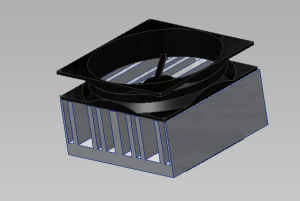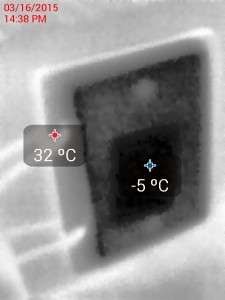As of May 27, 2015:
Please join our Github page to contribute. I’ve added the CAD assemblies / parts to work towards designing this project.
-Joe
As of May 21, 2015:
CAD work has begun. Any SPS / APC members wishing to contribute should install Autodesk Inventor 2015 (Free student copies!) and email Joe Sheldon for information on how to access the files.
Here’s an early mockup of the device, and the TEC cooling device:
-Joe
As of April 22, 2015:
UPAC has allocated SPS $481.29 towards:
- 12V DC Power supplies
- Heating Elements
- Projector Cart
- Glass/Fish Tank
- Misc Electronics
- Misc Hardware
- Glass Cutter
- 120mm Fans
- Power Strip
- LED Lighting
- Silicone Tubing
- Peristaltic Pump(s)
Please note: We already have a projector cart. I believe this to be in error, so we won’t be buying a second cart.
We are excited to start the build, proper. Given the timing it’s likely we’ll continue after the summer break rather than doing it during the summer – to give the most members the chance to participate!
-Joe
As of April 17, 2015:
Our meeting with UPAC went well. In addition to the Cloud chamber, we also requested funding for the radio telescope and Paul Trap. We will find out Tuesday, April 21 how much funding we will get towards the project. Other funding sources are being explored – 3D printing small trinkets and selling coffees are but two of the examples.
–Joe
As of April 8, 2015:
Currently, the “chamber” looks like:
There’s a lot of work ahead of our group to build this device. The cart was found in the Osmond Lab’s salvage pile – that’s $150 we don’t have to spend. Authorization to take this from salvage was granted, as the project is for university use. The Peltier elements, thermocouples (and amps), arduino, and LCD screen were provided by ECoS Student Council’s funding. These will serve as both the user interface and the cooling system for the alcohol vapor.
I’ve characterized the Peltier Elements (the six heatsinked items on the top shelf) with a thermal imager. We need something like -20C on the cold end, so stacking Peltier devices is a must. The thermogram is reproduced below (white hot/black cold).
We need to design the regulator circuits for the TECs. The plan is to use the LM338 family regulator with a digipot to control the power delivered to the TEC. It’s important to note that thermostat / PWM styled control will damage a Peltier device. Incidentally, this circuit and resultant PCB will be in common with the TEC circuit for the radio telescope’s Peltier control.
As of now, we are waiting on UPAC funding. Thanks must be shared with the ECoS student council for funding part of our project!
–Joe




